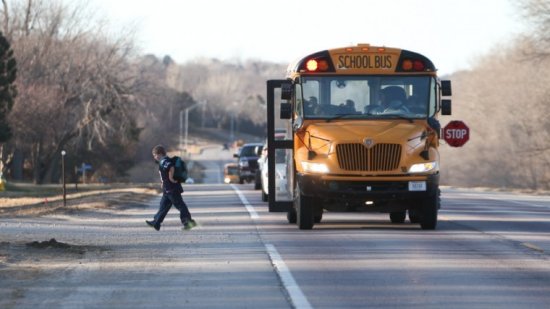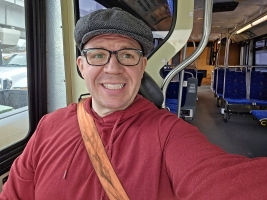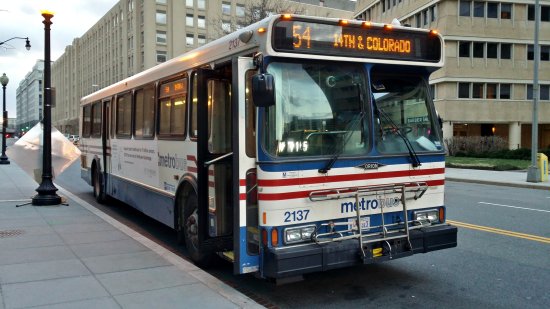Augusta County puts enforcement cameras on its school buses…
May 20, 2015, 12:09 PM
I recently read in an article in The News Leader that Augusta County Public Schools, where I went to middle and high school, is partnering up with the local sheriff’s office to outfit two of its school buses with cameras. These particular cameras are mounted on the exterior of the bus, on the left side, and are designed to catch people who pass a stopped school bus while their red warning lights are flashing. Normally, drivers in all directions are supposed to come to a complete stop when the bus’s red warning lights are flashing and the stop arm is out.
Now we all know better than to think that this always happens. I’ve written about school bus stops before, in regards to whether a right turn that begins just beyond a stopped school bus and moves away from it is a legal movement, or if it’s not. I casually asked a Montgomery County police officer about this one time while I was out and about, and he said that it wasn’t a legal move, describing the area where drivers are required to come to a full stop for a school bus as being like a bubble, rather than as a line of demarcation. I would have loved for the move that I described to have been legal, because then I could just zip past and be on my way. But apparently, it’s not.
Also, for those of you who have never driven a large vehicle before, let me let you in on something: if you think that the people around you drive like wackos when you’re in your car, you haven’t seen anything until you’ve watched drivers around a large vehicle. The “wacko” factor gets turned up to eleven when you’re driving a large vehicle. After all, large vehicles are very different than your car. They’re big, they’re heavy, and they’re slow. And in the case of school and transit buses, they make frequent stops. Drivers in cars know that, and as such, will do anything, even some very unsafe/illegal moves, to get past or otherwise not have to wait for a bus. I have been cut off in just about every way imaginable when I’m driving the bus, and I don’t get special privileges like school buses get, i.e. I don’t get to stop all traffic when I’m boarding and alighting passengers. And even if I could, fellow road users are still very poorly behaved and would stop at nothing to get past or around me while I was stopped, threat of ticket or not.
When I’m driving my car, I have places to go, and the last place that I want to be while I’m driving is behind a school bus. I’ve never illegally passed one, but I can definitely understand why people would want to do it. Getting stuck behind a school bus, and having to stop for it while it does every single stop can easily add a lot of time to a trip, especially since they will often keep traffic stopped with the lights until every single child has found a seat on the bus. The last part is especially infuriating, because then, there are no children left on the road for me to potentially run over, so I see no reason to be held hostage by a school bus driver at that point. In other words, get the last kid on the bus, kill the lights, and let us get on with our day while they choose which one of their classmates to sit with.
The idea of placing enforcement cameras on school buses to catch drivers who pass a stopped school bus seems to be attacking the problem from the wrong angle. No one wants to see someone run a bunch of kids over on their way to or from school while they’re boarding or alighting the bus. However, the idea of camera enforcement like this seems to paint school bus drivers as these people who can do no wrong, and drivers of cars as dangerous psychos. And I’ve seen the way that school bus drivers drive where I live. It can be interesting to watch – from a safe distance. The use of enforcement cameras also leads me to think that this alleged problem is not a matter of safety. Rather, it seems like a way for cash-strapped localities to raise additional revenue. I generally take a very dim view of governments that, when faced with a legitimate problem, exploit said problem for revenue through enforcement means rather than looking more deeply at the problem to determine the root cause, and trying to solve that issue. However, fixing the root cause admittedly doesn’t raise as much money – if any – as exploiting it for enforcement revenue.
It all leads me to think that the typical school bus stop arrangement is a bit unrealistic and not as safe as one would like to think that it is if the achievement of a safe stop requires factors that are entirely outside of the driver’s control to be in complete compliance.
I drive a transit bus for a living (though I am fully qualified and licensed to operate a school bus), and in going about my work, I have to ensure that every single passenger stop that I make is as safe as possible. I can’t stop all traffic with lights. I can only alert others that I am about to stop, and make it impractical for other vehicles, including bicycles, to get around my bus on the side where the passenger transaction occurs. After all, if a passenger gets run over or otherwise injured while attempting to board or alight a bus, that falls on me. Thus a typical transit stop looks like this, seen here in this Schumin Web file photo:
As shown here, hazard lights are on, the door is within six inches of the curb, and due to the bus’s location relative to the curb, there is no way that a car or bicycle can strike a passenger while they are boarding or alighting. All passenger transactions are done between the sidewalk and the adjacent curb lane. Meanwhile, traffic is moving unimpeded on the other side of the road.
And as school buses go, nothing is more infuriating than having to stop for a bus that is doing a passenger stop where the entire transaction occurs on the same side of the street as the bus’s door, i.e. no one crosses the street. It also makes school buses extremely inconsiderate road users, since they singlehandedly have the power to make you late.
For a number of years, I’ve been tossing around various ideas on how to modernize school bus stop laws, and have school buses share the road with other users to where people won’t be so inclined to do everything that they can to get around a school bus so that they don’t get stuck behind it. The idea is to ensure that safety is achieved through factors that the bus driver can control, and be more considerate to other road users by limiting the instances where the full eight-way warning system is used.
In regards to the driver’s ensuring safety, it seems like many times, school bus stops are not done as safely as possible, i.e. using the bus itself to ensure safety. When I dug around on Google, it didn’t take long to find some examples of sloppy school bus stops:

Photo: Doré Law Firm

Photo: LoveHays.com
In both of these cases, the school bus is way out in the middle of the road, leaving the right side of the bus wide open. A car could easily fit through the space that these drivers left between the edge of the road and the door, potentially running the children over. If I made a stop like that in a transit bus, I would get nailed for unsafe operation, and rightly so: someone could get by on the right side of the bus, and run my passengers over. And no, the fact that the school bus has red stop lights on it is irrelevant. You’ve all seen how people can and do behave extremely poorly when on the road. The eight-way warning system, ultimately, is just decorative, because the person who is truly determined to get around a school bus will find a way, and that may very well include ignoring the lights and stop arm. The only thing protecting these students is the eight-way warning system, and the compliance of any other road users around them. I have seen people try to beat the red lights on a school bus, and that may include passing the bus in an illegal manner. And if someone is that determined to get around a bus, school or otherwise, no amount of lights will stop them.
Thus I have some recommendations to make passenger stops safer for the children being boarded and alighted, and also make school buses more considerate road users. After all, we all share the road, and each of us has as much right to use the road as the next guy.
First and foremost, it seems that everyone would be better served to make every use of the eight-way warning system count, i.e. only using it when traffic absolutely needs to be stopped. Nothing irritates me more when I’m driving than to have to come to a complete stop, only to have them scoop up a few kids on the same side of the road as the bus, or for a few kids to alight and then proceed away from the roadway without crossing the street. There is no reason for oncoming traffic to be required to stop in those situations, and if there is more than one lane for vehicles traveling in the direction of the school bus, they should be allowed to pass the bus while it is servicing the stop. That’s why I like what some school districts in Michigan are doing with their school buses: hazard light stops. These involve using the hazard lights to indicate that the bus is doing a passenger stop, rather than using the eight-way warning system, similar to the way transit buses indicate that a passenger stop is occurring. The way that these hazard light stops are implemented in Michigan, the following requirements must be met:
- Same-side stop, i.e. nobody crossing the street
- The bus needs to be completely out of the traffic lane if the speed limit is over 45 mph
- The bus cannot impede the flow of traffic on slower-moving roads
- No hazard light stops if there are more than two lanes of traffic
I would recommend taking this concept a little bit further. If a school bus is about to complete a passenger stop where no one is crossing the street, every stop should be a hazard light stop, regardless of road speed or width. The school bus should position itself as close to the curb or edge of the road as is possible and safe, similar to a transit bus, and then do its stop, while letting other drivers go about their business. If there is a wide shoulder on the road, the school bus should perform its stop there in order to keep the right side closed. However, if you lift the lane restriction, the speed restriction takes care of itself because traffic can move around the stopped bus. I see it all the time with transit buses. The people who can get around the bus do, and those that can’t stop and wait. And I live and work in the area with the country’s worst drivers. Likewise, I’ve noticed that on narrow streets, the drivers behind the bus are less likely to try to play games with the bus while it’s doing a stop. And honestly, the kind of driver that is going to hit a bus while it’s performing a passenger stop most likely would hit said bus regardless of whether they had the eight-way warning system on or not.
Thus as far as I’m concerned, the only time that a school bus should ever activate its eight-way warning system is if there is a need for children to cross the road. If you make every use of the eight-way warning system count by only using it when necessary, it may very well get more respect than it currently gets. After all, we don’t want children to be run over by oncoming traffic, and owing to less-developed judgment as compared to adults, if it is necessary for a child to cross a street, we should stop traffic to facilitate that. But then once the child is on the bus, close the door and kill the lights so that traffic can resume while the child finds a seat, i.e. the eight-way warning system goes off, and the stop becomes a hazard light stop.
I also like what Washington State has in its laws regarding when drivers have to stop for school buses:
The driver of a vehicle upon a highway with three or more marked traffic lanes need not stop upon meeting a school bus which is proceeding in the opposite direction and is stopped for the purpose of receiving or discharging school children. (RCW 46.61.370)
In other words, if the road is three or more lanes wide, drivers in Washington State traveling in the opposite direction never have to stop for a school bus, even if the eight-way warning system is activated. As far as I’m concerned, this makes for safer children, because oncoming traffic will never stop for a school bus, meaning that children have to be dropped off on the same side of the road as their destination. And in all honesty, this is how it should be all over the country. I always considered it somewhat silly for a school bus stop on, for instance, US 340 in Stuarts Draft, which is a five-lane undivided highway, to stop traffic in all five lanes. I consider it somewhat unrealistic to ask a child to cross a five-lane road in the first place, even with the traffic allegedly stopped, because in that sort of width, it’s easy to miss a school bus, stopped or not. Likewise, it is extremely inconsiderate to require traffic on a five-lane road, i.e. most likely a major thoroughfare, to have to stop for a passenger stop that does not involve anyone crossing a road. Eliminating the requirement for opposing traffic to stop for a school bus on a road wider than two lanes makes for a more considerate school bus, because it creates far fewer opportunities for a school bus to impede traffic unnecessarily.
Combine the Washington State law with my suggestion for hazard light stops for all same-side stops, and I think you have a winning formula. It would limit the use of the eight-way warning system to where traffic is stopped only when it is absolutely necessarily: when a child needs to cross a two-lane road to reach their destination. Otherwise, there is no reason to stop everything for a school bus, as long as the stop is made safely, i.e. there is no way for a child to be struck by other traffic because the door area is properly closed off. And in that case, all you need are hazard lights to indicate that the vehicle is stopped.
Of course, in order to make what I suggest possible requires changes to existing laws. Will it ever happen? Perhaps, but I consider it somewhat unlikely, since this is a lucrative problem. Like many problems that governments like to exploit for revenue, a real solution to a problem doesn’t make any money. And why fix a problem when you can use it to raise money by writing tickets for people who allegedly violate these problematic laws? But if we can make school buses more considerate users of the road by eliminating much of their ability to stop traffic unless absolutely necessary, we can create a much safer environment for all involved.
Categories: Driving, School buses, Transit, Virginia local news











